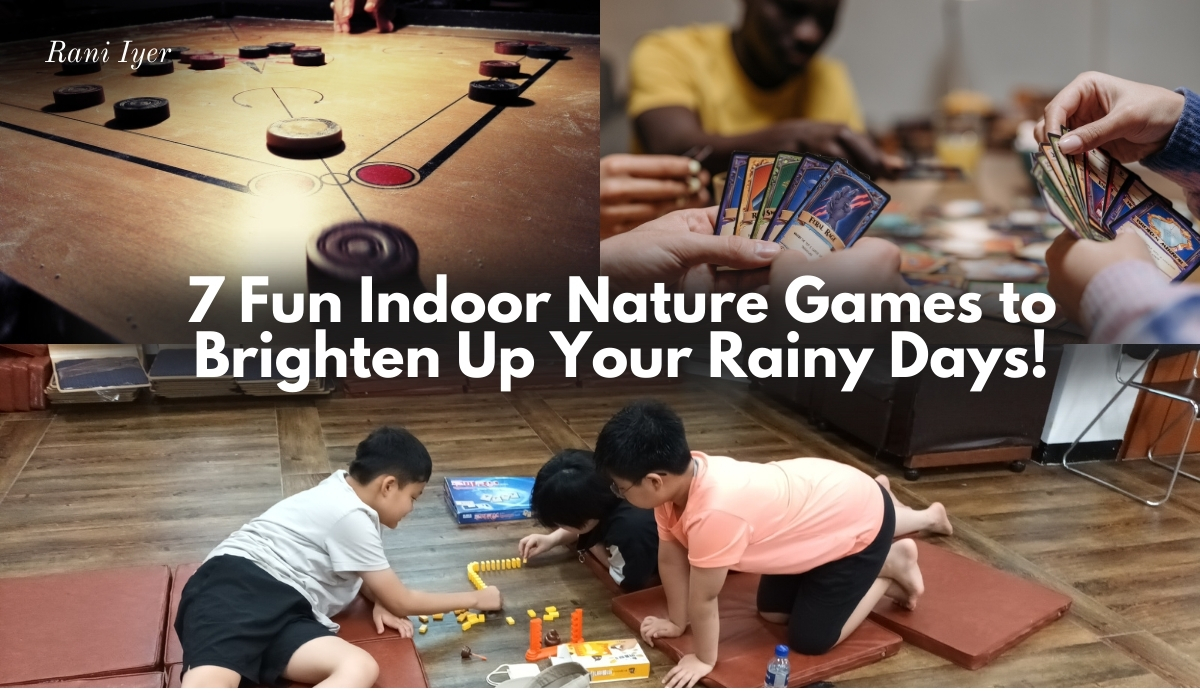7 Fun Indoor Nature Games to Brighten Up Your Rainy Days!
Rainy days don’t have to mean boredom and indoor confinement! Instead of being stuck inside scrolling through screens, why not embrace the cozy ambiance and connect with nature without stepping outside? In this article, we’ll explore 10 fun indoor nature games that will shake off the musty blues and turn your living room into a vibrant sanctuary of exploration and creativity. From scavenger hunts that spark curiosity to crafting activities inspired by the great outdoors, these engaging games are perfect for all ages. Get ready to transform those gloomy days into opportunities for adventure and laughter, encouraging everyone to channel their inner explorer. So grab your supplies, rally your friends and family, and let the fun begin! With these delightful activities, you’ll discover that rainy days can be just as exciting as sunny ones—if not more!
Benefits of Playing Nature-Inspired Games Indoors
Rainy days often come with a sense of confinement, leaving many of us longing for the outdoors. Yet, they also present a unique opportunity to explore new forms of entertainment that can provide educational and emotional benefits. Nature-inspired indoor games are a fantastic way to engage the mind, stimulate creativity, and promote a love for the environment, all while staying dry and cozy inside. These activities not only foster a sense of curiosity but also enhance cognitive skills such as problem-solving, critical thinking, and imagination.
Additionally, nature-themed indoor games can be deeply therapeutic. The act of engaging with elements of nature, even in a simulated environment, can reduce stress and boost overall well-being. Studies have shown that interacting with nature, or even just thinking about it, can lower cortisol levels and improve mood. These games also provide a wonderful opportunity for family bonding. Working together on a scavenger hunt, building a terrarium, or creating nature crafts can create lasting memories and strengthen relationships.
Moreover, incorporating nature into your indoor activities encourages a greater appreciation and understanding of the natural world. As children and adults alike learn about different plants, animals, and ecosystems through these games, they develop a deeper respect for the environment. This can lead to more environmentally conscious behaviors and a lifelong passion for nature. So, the next time it rains, don’t view it as a limitation; see it as an invitation to discover the wonders of nature from within your home.
Game 1: Nature Scavenger Hunt
A nature scavenger hunt is a delightful way to bring the outdoors inside. This game can be easily adapted to fit the indoor environment and can be played by people of all ages. To get started, create a list of nature-related items that participants need to find around the house. These items can range from a leaf-shaped object to something green, or even an item that has a texture reminiscent of tree bark.
To enhance the experience, you can include riddles or clues that lead to each item. This adds an element of mystery and excitement, as players must use their problem-solving skills to decipher the clues and locate the items. For example, a clue might read, “I am green and grow tall, but inside I’m small and round,” leading players to find a pea pod in the kitchen. This not only makes the game more engaging but also educational, as participants learn about different aspects of nature.
Once all the items have been found, gather everyone together to share their finds and discuss why each item fits the nature theme. This is a great opportunity to talk about the characteristics of the natural world and how they can be represented in everyday objects. You can also add a creative twist by encouraging participants to arrange their collected items into a nature-inspired collage or display. This turns the scavenger hunt into an art project and allows for further exploration of creativity and imagination.
Game 2: Indoor Gardening Challenge
Gardening is a wonderful way to connect with nature, and it doesn’t have to be confined to the outdoors. An indoor gardening challenge can transform your living space into a mini garden and provide endless entertainment and learning opportunities. Start by gathering some basic supplies such as small pots, soil, seeds, and watering cans. Choose plants that are well-suited for indoor growth, such as herbs, succulents, or small flowering plants.
To make the challenge more engaging, turn it into a competition. Each participant can choose a plant to grow and decorate their pot uniquely. Set up a schedule for watering and caring for the plants, and track their progress over time. You can even create a chart to record each plant’s growth and health. This not only instills a sense of responsibility but also teaches valuable lessons about patience, nurturing, and the life cycle of plants.
Additionally, you can incorporate educational elements into the challenge. Discuss the different needs of each plant, such as sunlight, water, and nutrients. Explain how photosynthesis works and the importance of plants in the ecosystem. To take it a step further, you can explore topics like composting, recycling, and sustainable gardening practices. This turns a simple indoor activity into a comprehensive learning experience that promotes environmental awareness and appreciation.
Game 3: Nature Art and Craft Activities
Art and nature go hand in hand, and there’s no better way to spend a rainy day than by creating beautiful nature-inspired crafts. These activities allow for endless creativity and can be tailored to suit all ages and skill levels. Start by gathering natural materials such as leaves, twigs, pinecones, and stones. If you don’t have access to these items, you can use craft supplies like colored paper, paint, and clay to create nature-themed artworks.
One fun activity is leaf printing. Collect leaves with interesting shapes and textures, dip them in paint, and press them onto paper to create beautiful prints. This technique can be used to make greeting cards, wall art, or even fabric designs. Another idea is to create nature collages using a variety of materials. Arrange leaves, twigs, and other natural items on a piece of cardboard or canvas to create a textured and visually appealing artwork.
For a more hands-on project, try making clay or salt dough sculptures inspired by nature. You can create animal figures, plant shapes, or even miniature landscapes. Once the sculptures are dry, paint them with vibrant colors to bring them to life. These activities not only stimulate creativity but also provide an opportunity to learn about different aspects of nature, such as plant anatomy, animal habitats, and ecosystems. Plus, the finished products make wonderful decorations and keepsakes that remind you of your rainy day adventures.
Game 4: DIY Terrarium Building
Creating a terrarium is a fantastic way to bring a piece of the natural world into your home. This miniature garden enclosed in glass is not only visually appealing but also provides a unique opportunity to learn about plant ecosystems and care. To get started, you’ll need a clear glass container, small plants such as succulents or mosses, pebbles, activated charcoal, potting soil, and decorative elements like small figurines or stones.
Begin by layering the bottom of the container with pebbles to create drainage. Add a thin layer of activated charcoal to help prevent mold and odors. Next, add potting soil and carefully plant your chosen greenery. Arrange the plants in a visually pleasing manner, leaving enough space for them to grow. Finally, add decorative elements to personalize your terrarium. This could be anything from small animal figurines to colorful stones or even tiny fairy garden accessories.
Once your terrarium is complete, take time to learn about the care requirements of the plants you’ve chosen. Discuss the importance of light, water, and humidity in maintaining a healthy terrarium. This is also a great opportunity to talk about the water cycle, photosynthesis, and plant respiration. By creating and maintaining a terrarium, you’ll not only have a beautiful addition to your home but also a living educational tool that can spark curiosity and a love for gardening.
Game 5: Nature-Themed Charades
Charades is a classic game that can easily be adapted to include a nature theme, making it a fun and educational activity for a rainy day. To play nature-themed charades, create a set of cards with different nature-related words or phrases. These can include animals, plants, natural phenomena, or even actions related to nature, such as “butterfly,” “thunderstorm,” “tree,” or “planting a seed.”
Divide players into two teams and take turns having one member of each team act out the word or phrase on the card while their teammates try to guess what it is. Acting out the clues without speaking encourages creativity and quick thinking, and it can lead to lots of laughter and fun. To make the game more challenging, set a time limit for each round or use more complex terms and phrases.
Playing nature-themed charades not only provides entertainment but also helps players learn about different aspects of the natural world. It can be a great way to introduce new vocabulary and concepts to children in a playful and engaging manner. After each round, take a moment to discuss the word or phrase and share interesting facts or stories related to it. This adds an educational element to the game and helps reinforce the knowledge gained through play.
Game 6: Indoor Birdwatching Station
Birdwatching is a popular pastime that can be enjoyed indoors with a bit of creativity. Setting up an indoor birdwatching station by a window allows you to observe and learn about local bird species without braving the rain. Start by placing a bird feeder outside your window to attract birds. You can use store-bought bird feeders or make your own using materials like pinecones, peanut butter, and birdseed.
Once your bird feeder is set up, create a comfortable viewing area inside with binoculars, a notebook, and bird identification guides. Spend time observing the birds that visit your feeder and try to identify them using the guides. Take notes on their appearance, behavior, and any unique characteristics. This activity can be both relaxing and educational, providing an opportunity to learn about different bird species, their habits, and their role in the ecosystem.
To enhance the experience, you can create a birdwatching journal to record your observations and sketches. This can be a fun way to track the different species you see over time and reflect on your birdwatching adventures. You can also make bird-themed crafts or play bird identification games to reinforce what you’ve learned. Indoor birdwatching is a wonderful way to connect with nature, even on the rainiest of days, and it can spark a lifelong interest in birding and wildlife conservation.
Game 7: Nature Storytelling Circle
Storytelling is a timeless activity that can be enriched with a nature theme to create a magical and educational experience. Gather your family or friends in a cozy circle and take turns sharing stories inspired by nature. These can be real-life experiences, imaginative tales, or even retellings of myths and legends related to the natural world. Encourage everyone to use vivid descriptions and incorporate elements like animals, plants, and natural phenomena into their stories.
To help spark creativity, you can use storytelling prompts or nature-themed story cards. These can include phrases like “Once upon a time in a magical forest,” “A brave explorer discovered a hidden valley,” or “A mysterious creature emerged from the river.” Prompts like these provide a starting point for the stories and help participants dive into their imaginations. This activity not only promotes creativity and communication skills but also fosters a deeper appreciation for nature.
After each story, take a moment to discuss the themes and elements of nature that were included. This can lead to interesting conversations about the natural world and its many wonders. You can also use this time to share facts and information related to the stories, turning the storytelling circle into an educational experience. By blending creativity with learning, a nature storytelling circle can transform a rainy day into a memorable and enriching adventure.
Conclusion and Encouragement to Explore Nature Indoors
Rainy days provide a perfect opportunity to explore the wonders of nature from the comfort of your home. The games and activities we’ve discussed not only offer entertainment but also promote learning, creativity, and a deeper connection with the natural world. By engaging in these nature-inspired indoor activities, you can transform a gloomy, rainy day into an exciting adventure filled with discovery and joy.
Whether you’re embarking on a scavenger hunt, nurturing indoor plants, creating nature crafts, building a terrarium, playing charades, birdwatching, or sharing stories, each activity brings a unique way to connect with nature. These games encourage curiosity, foster environmental awareness, and provide valuable learning experiences for people of all ages. They also offer a wonderful opportunity for family bonding and creating lasting memories.
So, the next time the rain keeps you indoors, don’t let it dampen your spirits. Embrace the opportunity to explore nature in new and creative ways. Gather your supplies, rally your friends and family, and dive into the fun and educational activities that bring the beauty and wonder of the natural world into your home. With these delightful games, you’ll discover that rainy days can be just as exciting and enriching as sunny ones, if not more!




